Phantasy Star Online: Episode I & II
Review - Tom goes online with the Cube. Phinally.
According to messrs Nintendo, Infogrames and Sega, this is the first online game for a next-gen console in Europe! Well, that's just plain bollocks, isn't it? Xbox Live has been kicking around since the end of November, the PS2 has had online games to some degree for ages (like Tony Hawk), and wasn't the Dreamcast supposedly next-gen anyway? Let's not get bogged down by semantics, you might well say, but hey, we're not the ones who wrote the silly press release.
So what is special about Phantasy Star Online: Episode I & II, apart from the crap name, the distinction of being the first online Cube game, and a dynasty of old-school turn-based RPGs?
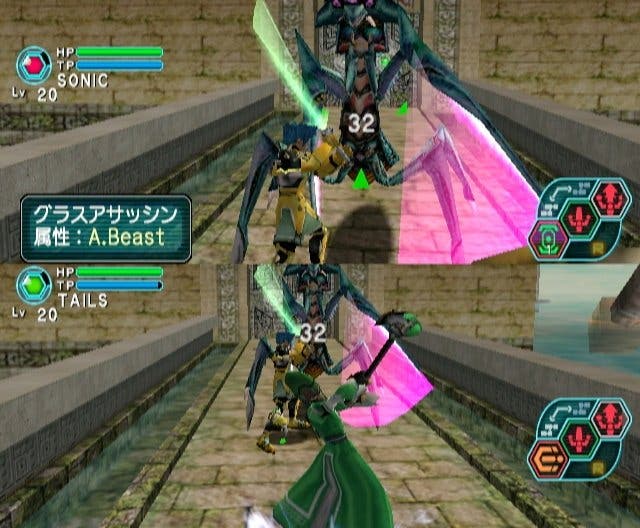
Up and under
You'd think Nintendo would want something mainstream and accessible for its first online game. Tellingly, PSO is exactly the opposite. Fortunately, it makes up for it by being bizarrely addictive when played by more than a lone player, and it gets this aspect of the game right most of the time. However, it also makes plenty of mistakes. Cripes - three paragraphs in and we're already bouncing back and forth like war propaganda. We knew this would happen.
The game is, at its simplest, a hackandslashy science fiction RPG played by one-to-four players, in which the protagonists - colonials looking for a new home in the stars - are seeking to find out why the planet Ragol and an early settlement has been ripped to shreds by a big explosion, and where all the people have gone. The game is played out on and below the surface of the planet as a band of adventurers fight wave after wave of plodding enemies in pseudo-real-time, collecting money and upgrades in their wake and from crates scattered by the explosion.
The original Dreamcast game (including the version 2 upgrade) is there in full, and the "Episode II" element (you can see how it gets confusing) adds a raft of new content in the same game engine. It can be played offline by one player, by two-to-four in split-screen mode, or online by a single player co-operating with up to three others in a party. Sadly, you can't have people on your end make up the numbers in split-screen - an annoying restriction, but with a very tightly controlled serial/key/password system governing the online element, and a monthly subscription fee, you can sort of understand why.
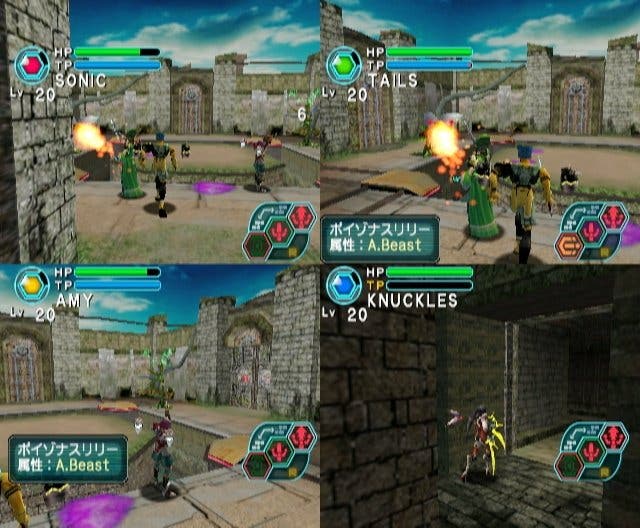
Off and on
Instead of splitting the game up into single and multiplayer chunks, you simply play through the same levels and have more enemies to face depending on the numbers. In each case, you have to set up a character to start with, choosing from one of three classes and four sub-classes each, which all differ in their abilities. To quickly run through each one; Hunters are proficient with bladed weapons; Rangers specialise in projectile weaponry; and Forces are sort of wizardlike, with various spells which make up for their physical weakness. However in PSO, these are called "Techniques", and use TP instead of MP. Semantics again.
The Episode I element comprises four main areas: the Forest (with slashy humanoid "Booma" enemies, wolves and little yellow penguin-looking bastards), the Caves (with sharks and Nova dragons), the Mines and the Ruins. We lost interest in the latter stage enemies long ago and can't remember their names. Of the four sections, the Forest is easily our favourite, with its reasonable learning curve, increasingly cool battles (big, gorilla look-alikes turn up eventually at four times the size of a Booma) and one of the best bosses in the game - a big red dragon. However, none of them varies much from the hackandslash principles, and ultimately the gameplay is mainly about collecting items and doing whatever's needed to open the next door (almost universally by one of two activities; killing all the enemies in one area or just finding a switch nearby). Any variation in gameplay can be found in the enemies you face and the kit you acquire. OK, you can download quests from Pioneer 2 (and the Sega servers), which flesh out the story a little more, but they all take place in the same levels.
The act of walking around and clobbering people is admittedly quite fun. The lightsaber-wielding Hunters get the best of it, and the combat is based around a measured three-tap system (tap - downward stroke - tap - horizontal stroke - tap - uppercut). As you go on, you gradually accumulate better weapons from the crates you find and shops you visit back on your mothership, the Pioneer 2, and Techniques from special disks which are strewn around the same locations. Weapons, techniques and items can all be bound to the various face buttons on the controller through a complicated menu system, and eventually your little Mag - a sort of shoulder-mounted Tamagotchi who must be fed items regularly - will learn how to pull off massively powerful techniques which are best employed against bosses.
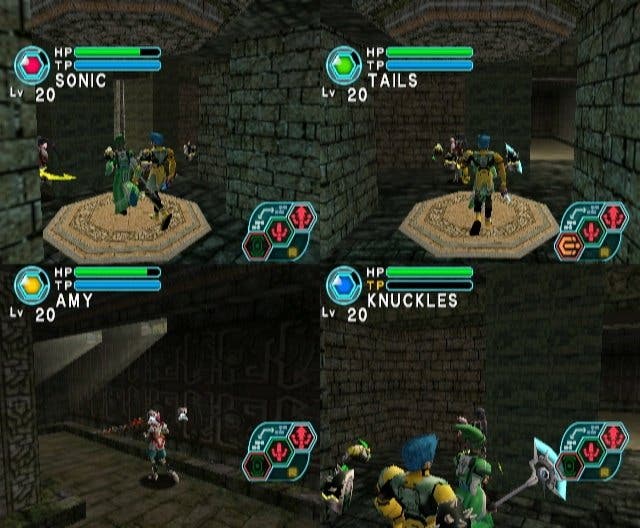
One to four
But playing the game on your own can be pretty tedious. It takes a long time and a lot of battles to level up your character to boss-beating status, and as you start out you'll often find yourself dying regularly or running out of Monomate (cough, health potion) and retreating to Pioneer 2 to tool up again. And of course this style of hack, slash, die, rinse, repeat only really appeals to a particular brand of gamer, and I'm not really one of them. Shove in a social context though and I'll happily play Diablo II until the early hours, and that's where PSO really excels - in that close-knit, team co-op guise. Get a few friends together and play online and it's amazing. You share experience by contributing to the death of the same enemy; thus you can help build up lesser players by having them dart in and smack an enemy once before you finish it off. You can fight over the loot. You can work through a level in a couple of little groups. You can even chat away happily - with the appropriate keyboard peripheral. And to a certain extent, the game is also fun in split-screen mode. To a certain extent.
Beyond that extent, we have the communal map overlay, which obscures a lot of the playing area despite some vague attempt at translucency, the absolutely ridiculous pop-up even in two-player (we used the term "Daytona-level pop-up" recently, but we're going to switch to "PSO GC-level pop-up"), and a camera which at times just does not want to show you the game. It's OK in single player with a big screen to peer at, but in little split-screen boxes you'll find that getting backed up by monsters often means you're left with screen clutter and big, fat, indecipherable graphics pulsating against the camera like a bloody ultrasound scan. "Where's the enemy? I don't see it." It's even worse in boss battles, particularly with dragons, because it only wants to look at their heads, meaning you get stomped because you can't see where you are. Honestly, Sega, did you even test this?
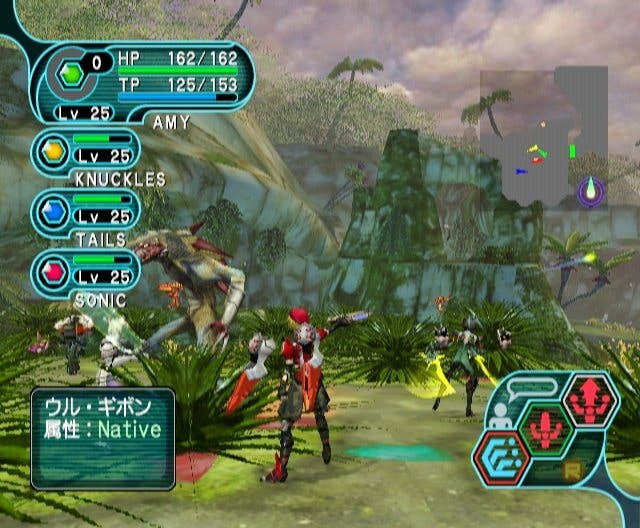
Down and down
Eek, we almost commenced the downward spiral towards the verdict you've already glanced at. But before we do, let's stick with what we do like about PSO, because for all its flaws (and it's taking a lot of typing to fit them all in), it does have some serious merit. To reiterate what's gone before, it's very addictive in multiplayer over the Internet, and for some, as a whole. The reward structure is great, with irregular level-ups interwoven with new weapons, new armour, new Mag levels and new enemies. However, the graphics have lost some of their sheen, so it's no longer a visual reward, but more of that later.
Still on the friendly tack though, the online setup and network attached seem to be in pretty good nick. We've tried the game using both broadband and modem adapters (although Nintendo's PR company was only allocated ten of the former for the entire UK press so we had to buy one), and set up is logical, albeit occasionally a bit confusing. Anybody with a smattering of network skills will be able to set either up. For broadband, we had to set a manual IP address because PSO refused to talk to our DHCP server, but that's about it.
As for lag, we didn't spot any, except a reasonable amount via modem, and the download pod in the City area came furnished with the promised NiGHTS GBA port. Handy, and a good reason to invest in the GBA-to-GC connector, although you'll have to finish the mini-game specific quests first.
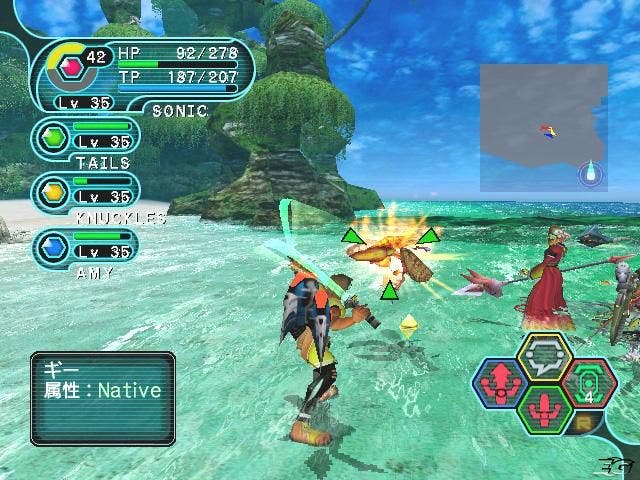
Money, money, money
That said, you can't be expected to invest in every Cube peripheral under the sun, and that's what PSO seems to want you to do. You'll need a broadband or modem adapter to play it with other people at all, and that's £35, and then there's the keyboard peripheral from Datel or whoever, which is another £20. These are almost obligatory in order to gain much from the title - using the on-screen keyboard is horrible, and the Cube will only talk to the Internet using a standard, 'Nintendo-made-this' peripheral. Sorry. So that's £55 on top of the cost of the game.
To take advantage of the downloadable GBA games, that's another £7 or so for the cable, and since the game uses 28 blocks of your memory card, you're probably going to need another one of those (no reasonably longstanding Cube owner is going to have 28 blocks free on their main memory card, however poor the software situation has been). So you're looking at a big, big investment for a game which will only probably return it - and has rather insultingly been available on another system for several years. The only reason you can't play it on those any more (with all the peripherals you bought then) is that Sega turned the servers off - oh, and now they want £5.99 / €8.99 a month after a 30-day preview period for you to continue doing so.
What are they offering to justify this besides an ageing RPG? A smattering of new content (a few levels, bosses, weapons and so on), broadband support and a split-screen option - all things which should have been in "version 2". And they're still peddling those "you must walk to this specific two-metre-squared area to spawn baddies which, when dispatched, will unlock the doors you can't figure out" situations. Bad Sega, bad!
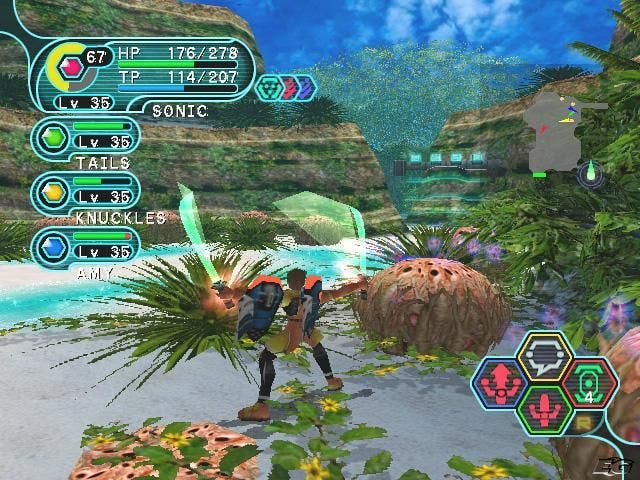
Final Phantasy: Please
Aaaand we've been waiting to go on about the graphics, so indulge us; characters look like paper chain men with textures pasted onto them, and don't really do anything other than run like podgy charity workers dressed up as bears during the 24th mile of the marathon, occasionally halting to swing their swords or whathaveyou, animals move slowly and without much variation, and sometimes get caught jerking against the scenery, the collision detection is awful, and the environmental effects consist of little jets of water sprinkling out of octagonal pipes (which, without the water, we wouldn't be able to identify) and bubbling lava. The environments are even starting to look shabby now, with the exception of the new Beach area in Episode II, which looks rather splendid as you can see in the screenshots.
Phantasy Star Online has been kicking around for a long time now, and with each successive "update", Sega seems keen to endorse the snappy new slogan we dreamt up for it: Yesterday's Technology Tomorrow. This one is admittedly better value for money than the rather uninspired "version 2" Dreamcast release, but for a game which has seen as much development as this to suffer from fundamental flaws and dodgy design decisions in so many areas is bizarre.
Sega fans should rush out and buy it for the new content, ignoring every single word we say as the blinkers slowly unwind to obscure life outside Ragol, and die-hard fans of the genre will probably go for it - and more power to them, but they will want one of those keyboard pads too, unless they plan to stick with four stock phrases and a few smileys for the rest of eternity. Meanwhile, PSO virgins will find the package unwieldy and confusing to start with, and the online element a bit inaccessible. It's worth persevering with if you've got a regular group to play with online, but otherwise it just plain is not. Not any more. Too complicated for most humans, and it's going to be a lot more cost-effective on Xbox anyway, hence the score.
Phantasy Star Online: Episode I & II screenshots (Xbox)

